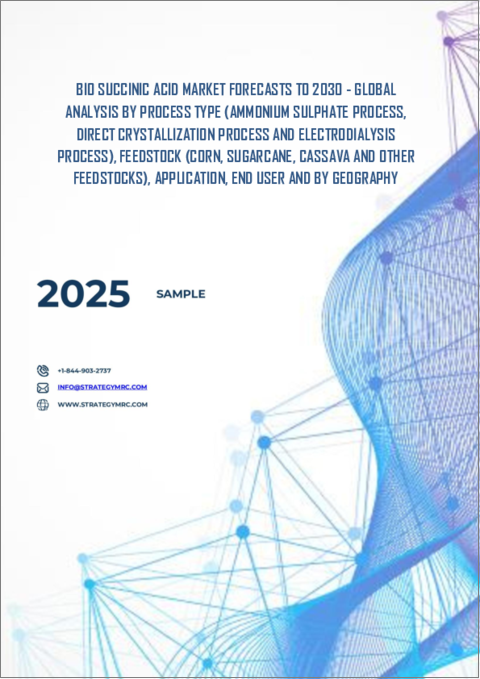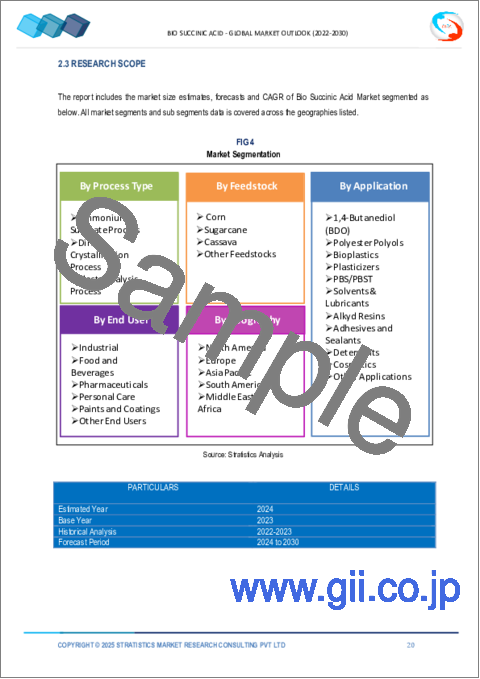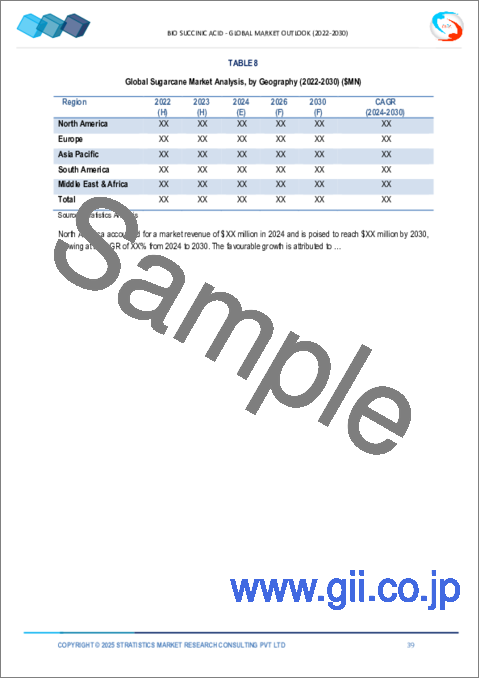|
|
市場調査レポート
商品コード
1636661
バイオコハク酸市場の2030年までの予測:プロセスタイプ別、原料別、用途別、エンドユーザー別、地域別の世界分析Bio Succinic Acid Market Forecasts to 2030 - Global Analysis By Process Type, Feedstock, Application, End User and By Geography |
||||||
カスタマイズ可能
|
|||||||
| バイオコハク酸市場の2030年までの予測:プロセスタイプ別、原料別、用途別、エンドユーザー別、地域別の世界分析 |
|
出版日: 2025年01月01日
発行: Stratistics Market Research Consulting
ページ情報: 英文 200+ Pages
納期: 2~3営業日
|
全表示
- 概要
- 図表
- 目次
Stratistics MRCによると、バイオコハク酸の世界市場は2024年に1億4,638万米ドルとなり、2030年までには3億2,299万米ドルに達すると予測され、予測期間中のCAGRは14.1%です。
バイオコハク酸は、砂糖、トウモロコシ、バイオマスなどの再生可能な原料から発酵によって製造されるバイオベースの化学物質です。石油由来のコハク酸の持続可能な代替品となり、環境や炭素排出への影響も少ないです。バイオコハク酸は、食品、医薬品、プラスチック、ポリウレタン、樹脂、パーソナルケア用品など、さまざまな産業で使用されています。
米国エネルギー省によると、バイオコハク酸は石油由来のコハク酸と比べ、温室効果ガスの排出を最大90%削減できるといいます。
持続可能な代替品への関心の高まり
世界中で持続可能性と環境保護が重視されるようになり、バイオコハク酸市場の拡大が顕著になっています。産業界が気候変動と戦うためにより環境に優しい選択肢にシフトする中、バイオコハク酸は石油から作られるコハク酸の競争力のある代替品となっています。トウモロコシやサトウキビなどの再生可能なバイオマスを原料とするバイオコハク酸の製造プロセスにより、温室効果ガスの排出と再生不可能な化石燃料への依存の両方が削減されます。さらに、バイオコハク酸は現在、多くの産業で持続可能な製造方法の重要な構成要素となっています。
高い製造コスト
石油由来のコハク酸に比べて生産コストが比較的高いことが、バイオコハク酸市場の足かせとなっている主な要因の1つです。発酵技術によって生産効率は大幅に向上しましたが、再生可能な原料、バイオテクノロジー・プロセス、精製方法にコストがかかるため、生産コストは依然として高いです。さらに、産業需要を満たすためにバイオコハク酸の生産を拡大するには、インフラへの多額の資本投資が必要であり、これは小規模メーカーにとっては困難で、市場の成長を制限する可能性があります。
グリーン建築材料の採用
環境への影響を低減するため、建設業界ではグリーンで持続可能な建築資材の使用が増加しています。建築関連のコーティング剤、接着剤、シーリング剤の重要な成分であるバイオベースのポリオールや樹脂は、バイオコハク酸から作ることができます。さらに、従来の建築材料に含まれる揮発性有機化合物(VOC)を規制する法律が厳しくなっていることに加え、環境に配慮したインフラ開拓の動向も高まっているため、バイオコハク酸の生産者にとっては、この成長市場に利益をもたらすチャンスとなっています。
石油化学ベースの代替品との競争
持続可能性がますます重要になりつつあるとはいえ、より優れたサプライ・チェーンとより低い生産コストのため、市場は依然として石油化学ベースのコハク酸が支配的です。いくつかの産業、特に開発途上国では、環境面よりもコスト面を重視するため、バイオコハク酸の使用が制限されています。さらに、石油化学産業の効率化とコスト削減による競争激化のため、バイオコハク酸の生産者が市場で大きな存在感を示すことは困難です。
COVID-19の影響:
COVID-19パンデミックはバリューチェーン全体に混乱を引き起こし、バイオコハク酸市場に大きな影響を与えました。ロックダウンや制限によるサプライチェーンの混乱により、生産スケジュールが遅れ、トウモロコシやサトウキビなどの重要な原料が容易に入手できなくなりました。製造業の操業停止と経済活動の低下により、建設、繊維、自動車などの最終用途産業におけるバイオコハク酸の需要は減少しました。さらに、パンデミックは、持続可能性とバイオベースの代替品の重要性を強調し、パンデミック後の数年間、政府や企業が環境に優しい解決策をより重視するようになり、市場回復の展望が開かれました。
予測期間中、直接晶析プロセス分野が最大になる見込み
バイオコハク酸は、その手頃な価格と広範な産業用途から、直接晶析プロセス・セグメントが最大の市場シェアを占めると予想されます。高い純度レベルと低い生産コストは、発酵ブロスからコハク酸を分離するこの非常に効果的な方法によってもたらされます。大規模な生産設備へのスムーズな統合と、さまざまな再生可能原料への適合性により、メーカーにとって最適な選択肢となっています。さらに、直接晶析プロセスは、食品添加物、医薬品、生分解性プラスチックなどの用途で増加するバイオコハク酸の需要を満たすために必要な拡張性をサポートすることで、市場の優位性をさらに強固なものにしています。
バイオプラスチック分野は予測期間中に最も高いCAGRが見込まれる
バイオコハク酸市場では、持続可能性とプラスチック廃棄物の削減に対する世界の関心の高まりにより、バイオプラスチック分野が最も高いCAGRを示すと予想されます。バイオコハク酸は、ポリブチレンサクシネート(PBS)やPBSベースのコポリマーなどの生分解性プラスチックの重要な成分であり、従来のプラスチックの環境に優しい代替品として人気が高まっています。消費者の意識の高まり、使い捨てプラスチックに対する法律の厳格化、環境に優しい包装オプションへのニーズの高まりが、バイオプラスチック市場を牽引しています。
最大のシェアを占める地域
持続可能性の重視、厳しい環境規制、確立されたバイオベースの化学産業により、欧州地域がバイオコハク酸市場で最大のシェアを占めると予想されます。同地域では、二酸化炭素排出量の削減と環境に優しい材料の使用に重点を置いているため、バイオコハク酸は建設、自動車、包装などのさまざまな産業で広く使用されています。さらに、欧州の市場拡大を支えているのは、バイオベース技術に対する政府の補助金や優遇措置、再生可能な原料を生産するための強力なインフラです。
CAGRが最も高い地域:
急速な工業化、持続可能な製品に対する需要の高まり、環境問題に対する意識の高まりにより、バイオコハク酸市場はアジア太平洋地域で最も高いCAGRで成長すると予測されます。製造業の規模が大きく、バイオプラスチック産業が成長し、環境に優しい製品に対する消費者の需要が高まっているため、中国、インド、日本などの国々が市場の重要なプレーヤーになりつつあります。さらに、この地域での市場の拡大は、バイオベースの化学物質の使用と再生可能な原料ソースの創出を奨励する政府プログラムによってさらに支えられています。
無料のカスタマイズサービス
本レポートをご購読のお客様には、以下の無料カスタマイズオプションのいずれかをご利用いただけます:
- 企業プロファイル
- 追加市場企業の包括的プロファイリング(3社まで)
- 主要企業のSWOT分析(3社まで)
- 地域セグメンテーション
- 顧客の関心に応じた主要国の市場推計・予測・CAGR(注:フィージビリティチェックによる)
- 競合ベンチマーキング
- 製品ポートフォリオ、地理的プレゼンス、戦略的提携に基づく主要企業のベンチマーキング
目次
第1章 エグゼクティブサマリー
第2章 序文
- 概要
- ステークホルダー
- 調査範囲
- 調査手法
- データマイニング
- データ分析
- データ検証
- 調査アプローチ
- 調査情報源
- 1次調査情報源
- 2次調査情報源
- 前提条件
第3章 市場動向分析
- 促進要因
- 抑制要因
- 機会
- 脅威
- 用途分析
- エンドユーザー分析
- 新興市場
- COVID-19の影響
第4章 ポーターのファイブフォース分析
- 供給企業の交渉力
- 買い手の交渉力
- 代替品の脅威
- 新規参入業者の脅威
- 競争企業間の敵対関係
第5章 世界のバイオコハク酸市場:プロセスタイプ別
- 硫酸アンモニウム法
- 直接結晶化プロセス
- 電気透析プロセス
第6章 世界のバイオコハク酸市場:原料別
- トウモロコシ
- サトウキビ
- キャッサバ
- その他の原料
第7章 世界のバイオコハク酸市場:用途別
- 1,4-ブタンジオール(BDO)
- ポリエステルポリオール
- バイオプラスチック
- 可塑剤
- PBST/PBST
- 溶剤と潤滑剤
- アルキド樹脂
- 接着剤・シーラント
- 洗剤
- 化粧品
- その他の用途
第8章 世界のバイオコハク酸市場:エンドユーザー別
- 産業
- 食品・飲料
- 医薬品
- パーソナルケア
- 塗料・コーティング
- その他のエンドユーザー
第9章 世界のバイオコハク酸市場:地域別
- 北米
- 米国
- カナダ
- メキシコ
- 欧州
- ドイツ
- 英国
- イタリア
- フランス
- スペイン
- その他欧州
- アジア太平洋
- 日本
- 中国
- インド
- オーストラリア
- ニュージーランド
- 韓国
- その他アジア太平洋
- 南米
- アルゼンチン
- ブラジル
- チリ
- その他南米
- 中東・アフリカ
- サウジアラビア
- アラブ首長国連邦
- カタール
- 南アフリカ
- その他中東・アフリカ
第10章 主な発展
- 契約、パートナーシップ、コラボレーション、合弁事業
- 買収と合併
- 新製品発売
- 事業拡大
- その他の主要戦略
第11章 企業プロファイリング
- DSM
- Kawasaki Kasei Chemicals
- Myriant Corporation
- BASF SE
- Roquette Freres S.A
- Mitsubishi Chemical Corporation
- Corbion Inc
- Reverdia
- BioAmber Inc
- Nippon Shokubai
List of Tables
- Table 1 Global Bio Succinic Acid Market Outlook, By Region (2022-2030) ($MN)
- Table 2 Global Bio Succinic Acid Market Outlook, By Process Type (2022-2030) ($MN)
- Table 3 Global Bio Succinic Acid Market Outlook, By Ammonium Sulphate Process (2022-2030) ($MN)
- Table 4 Global Bio Succinic Acid Market Outlook, By Direct Crystallization Process (2022-2030) ($MN)
- Table 5 Global Bio Succinic Acid Market Outlook, By Electrodialysis Process (2022-2030) ($MN)
- Table 6 Global Bio Succinic Acid Market Outlook, By Feedstock (2022-2030) ($MN)
- Table 7 Global Bio Succinic Acid Market Outlook, By Corn (2022-2030) ($MN)
- Table 8 Global Bio Succinic Acid Market Outlook, By Sugarcane (2022-2030) ($MN)
- Table 9 Global Bio Succinic Acid Market Outlook, By Cassava (2022-2030) ($MN)
- Table 10 Global Bio Succinic Acid Market Outlook, By Other Feedstocks (2022-2030) ($MN)
- Table 11 Global Bio Succinic Acid Market Outlook, By Application (2022-2030) ($MN)
- Table 12 Global Bio Succinic Acid Market Outlook, By 1,4-Butanediol (BDO) (2022-2030) ($MN)
- Table 13 Global Bio Succinic Acid Market Outlook, By Polyester Polyols (2022-2030) ($MN)
- Table 14 Global Bio Succinic Acid Market Outlook, By Bioplastics (2022-2030) ($MN)
- Table 15 Global Bio Succinic Acid Market Outlook, By Plasticizers (2022-2030) ($MN)
- Table 16 Global Bio Succinic Acid Market Outlook, By PBS/PBST (2022-2030) ($MN)
- Table 17 Global Bio Succinic Acid Market Outlook, By Solvents & Lubricants (2022-2030) ($MN)
- Table 18 Global Bio Succinic Acid Market Outlook, By Alkyd Resins (2022-2030) ($MN)
- Table 19 Global Bio Succinic Acid Market Outlook, By Adhesives and Sealants (2022-2030) ($MN)
- Table 20 Global Bio Succinic Acid Market Outlook, By Detergents (2022-2030) ($MN)
- Table 21 Global Bio Succinic Acid Market Outlook, By Cosmetics (2022-2030) ($MN)
- Table 22 Global Bio Succinic Acid Market Outlook, By Other Applications (2022-2030) ($MN)
- Table 23 Global Bio Succinic Acid Market Outlook, By End User (2022-2030) ($MN)
- Table 24 Global Bio Succinic Acid Market Outlook, By Industrial (2022-2030) ($MN)
- Table 25 Global Bio Succinic Acid Market Outlook, By Food and Beverages (2022-2030) ($MN)
- Table 26 Global Bio Succinic Acid Market Outlook, By Pharmaceuticals (2022-2030) ($MN)
- Table 27 Global Bio Succinic Acid Market Outlook, By Personal Care (2022-2030) ($MN)
- Table 28 Global Bio Succinic Acid Market Outlook, By Paints and Coatings (2022-2030) ($MN)
- Table 29 Global Bio Succinic Acid Market Outlook, By Other End Users (2022-2030) ($MN)
Note: Tables for North America, Europe, APAC, South America, and Middle East & Africa Regions are also represented in the same manner as above.
According to Stratistics MRC, the Global Bio Succinic Acid Market is accounted for $146.38 million in 2024 and is expected to reach $322.99 million by 2030 growing at a CAGR of 14.1% during the forecast period. Bio-succinic acid is a bio-based chemical that is made by fermentation from renewable feedstocks like sugar, corn, or biomass. It provides a sustainable substitute for succinic acid derived from petroleum, with less of an impact on the environment and carbon emissions. Bio-succinic acid is used in a variety of industries, such as food, medicine, plastics, polyurethanes, resins, and personal care items.
According to the U.S. Department of Energy, bio-succinic acid can reduce greenhouse gas emissions by up to 90% compared to petroleum-based succinic acid.
Market Dynamics:
Driver:
Growing interest in sustainable substitutes
The growing emphasis on sustainability and environmental protection around the world is driving a notable expansion in the bio-succinic acid market. As industries shift to more environmentally friendly options to fight climate change, bio-succinic acid has become a competitive substitute for succinic acid made from petroleum. Both greenhouse gas emissions and reliance on non-renewable fossil fuels are decreased by its production process, which uses renewable feedstocks like corn, sugarcane, and other biomass. Additionally, bio-succinic acid is now a crucial component of sustainable manufacturing methods in many industries.
Restraint:
High costs of production
The comparatively high cost of production compared to petroleum-derived succinic acid is one of the main factors holding back the bio-succinic acid market. Although fermentation technology has greatly increased production efficiency, the cost of production is still high because of the costs of renewable feedstocks, biotechnological processes, and purification methods. Furthermore, scaling up bio-succinic acid production to meet industrial demand requires a significant capital investment in infrastructure, which can be difficult for smaller manufacturers and limit market growth.
Opportunity:
Adoption of green building materials
To reduce its environmental impact, the construction industry is using more and more green and sustainable building materials. Bio-based polyols and resins, which are crucial ingredients in construction-related coatings, adhesives, and sealants, can be made from bio-succinic acid. Moreover, stricter laws governing volatile organic compounds (VOCs) in traditional building materials, along with the growing trend of environmentally friendly infrastructure development, present a profitable opportunity for producers of bio-succinic acid to serve this growing market.
Threat:
Rivalry from alternatives based on petrochemicals
The market is still dominated by petrochemical-based succinic acid because of its better supply chains and lower production costs, even though sustainability is becoming more and more important. Several industries, especially in developing nations, place a higher priority on cost than environmental advantages, which restricts the use of bio-succinic acid. Additionally, it is challenging for producers of bio-succinic acid to establish a substantial market presence due to the heightened competition caused by the petrochemical industry's improvements in efficiency and cost reduction.
Covid-19 Impact:
The COVID-19 pandemic caused disruptions throughout the value chain, which had a major effect on the bio-succinic acid market. Due to supply chain disruptions caused by lockdowns and restrictions, production schedules were delayed, and important feedstocks like corn and sugarcane were not readily available. Because of the halting of manufacturing operations and the decline in economic activity, the demand for bio-succinic acid in end-use industries like construction, textiles, and automobiles decreased. Furthermore, the pandemic did, however, also emphasize the significance of sustainability and bio-based substitutes, opening up market recovery prospects as governments and businesses place a greater emphasis on environmentally friendly solutions in the years following the pandemic.
The Direct Crystallization Process segment is expected to be the largest during the forecast period
The Direct Crystallization Process segment is expected to have the largest market share for bio-succinic acid because of its affordability and extensive industrial use. High purity levels and low production costs are provided by this highly effective method of separating succinic acid from fermentation broths. It is the go-to option for manufacturers due to its smooth integration into large-scale production facilities and compatibility with a variety of renewable feedstocks. Moreover, the direct crystallization process further solidifies its market dominance by supporting the scalability needed to meet the increasing demand for bio-succinic acid across applications such as food additives, pharmaceuticals, and biodegradable plastics.
The Bioplastics segment is expected to have the highest CAGR during the forecast period
The bioplastics segment is expected to have the highest CAGR in the bio-succinic acid market, driven by the growing global emphasis on sustainability and reducing plastic waste. Bio-succinic acid is a vital component of biodegradable plastics, such as polybutylene succinate (PBS) and PBS-based copolymers, which are becoming more popular as environmentally friendly substitutes for traditional plastics. Growing consumer consciousness, stricter laws aimed at single-use plastics, and an increasing need for environmentally friendly packaging options are driving the market for bioplastics.
Region with largest share:
Due to its strong emphasis on sustainability, strict environmental regulations, and established bio-based chemical industries, the European region is expected to hold the largest share of the bio-succinic acid market. The region's focus on cutting carbon emissions and using environmentally friendly materials has caused bio-succinic acid to be widely used in a variety of industries, such as construction, automotive, and packaging. Furthermore, supporting market expansion in Europe are government subsidies and incentives for bio-based technologies as well as a strong infrastructure for the production of renewable feedstock.
Region with highest CAGR:
Due to rapid industrialization, rising demand for sustainable products, and increased awareness of environmental issues, the bio-succinic acid market is predicted to grow at the highest CAGR in the Asia Pacific region. Because of their sizable manufacturing sectors, growing bioplastics industries, and growing consumer demand for environmentally friendly products, nations like China, India, and Japan are becoming important players in the market. Moreover, the market's expansion in this region is further supported by government programs encouraging the use of bio-based chemicals and the creation of renewable feedstock sources.
Key players in the market
Some of the key players in Bio Succinic Acid market include DSM, Kawasaki Kasei Chemicals, Myriant Corporation, BASF SE, Roquette Freres S.A, Mitsubishi Chemical Corporation, Corbion Inc, Reverdia, BioAmber Inc and Nippon Shokubai.
Key Developments:
In September 2024, Mitsubishi Corporation and Exxon Mobil Corporation have signed a Project Framework Agreement for Mitsubishi Corporation's participation in ExxonMobil's facility in Baytown, Texas which is expected to produce virtually carbon-free hydrogen with approximately 98% of carbon dioxide (CO2) removed and low-carbon ammonia.
In July 2024, BASF and ENGIE signed a 7-year Biomethane Purchase Agreement (BPA). Under the BPA, ENGIE will supply BASF with 2.7 to 3.0 terawatt hours of biomethane throughout the term of the agreement. BASF uses certified biomethane at its Ludwigshafen/Germany and Antwerp/Belgium sites as a sustainable alternative to fossil raw materials in its manufacturing process.
In March 2024, Roquette has acquired the pharma solutions division at International Flavors & Fragrances, in a deal up to $2.85 billion. It will also expand the company's position in the 'attractive' excipients market and enhance Roquette's US footprint.
Process Types Covered:
- Ammonium Sulphate Process
- Direct Crystallization Process
- Electrodialysis Process
Feedstocks Covered:
- Corn
- Sugarcane
- Cassava
- Other Feedstocks
Applications Covered:
- 1,4-Butanediol (BDO)
- Polyester Polyols
- Bioplastics
- Plasticizers
- PBS/PBST
- Solvents & Lubricants
- Alkyd Resins
- Adhesives and Sealants
- Detergents
- Cosmetics
- Other Applications
End Users Covered:
- Industrial
- Food and Beverages
- Pharmaceuticals
- Personal Care
- Paints and Coatings
- Other End Users
Regions Covered:
- North America
- US
- Canada
- Mexico
- Europe
- Germany
- UK
- Italy
- France
- Spain
- Rest of Europe
- Asia Pacific
- Japan
- China
- India
- Australia
- New Zealand
- South Korea
- Rest of Asia Pacific
- South America
- Argentina
- Brazil
- Chile
- Rest of South America
- Middle East & Africa
- Saudi Arabia
- UAE
- Qatar
- South Africa
- Rest of Middle East & Africa
What our report offers:
- Market share assessments for the regional and country-level segments
- Strategic recommendations for the new entrants
- Covers Market data for the years 2022, 2023, 2024, 2026, and 2030
- Market Trends (Drivers, Constraints, Opportunities, Threats, Challenges, Investment Opportunities, and recommendations)
- Strategic recommendations in key business segments based on the market estimations
- Competitive landscaping mapping the key common trends
- Company profiling with detailed strategies, financials, and recent developments
- Supply chain trends mapping the latest technological advancements
Free Customization Offerings:
All the customers of this report will be entitled to receive one of the following free customization options:
- Company Profiling
- Comprehensive profiling of additional market players (up to 3)
- SWOT Analysis of key players (up to 3)
- Regional Segmentation
- Market estimations, Forecasts and CAGR of any prominent country as per the client's interest (Note: Depends on feasibility check)
- Competitive Benchmarking
- Benchmarking of key players based on product portfolio, geographical presence, and strategic alliances
Table of Contents
1 Executive Summary
2 Preface
- 2.1 Abstract
- 2.2 Stake Holders
- 2.3 Research Scope
- 2.4 Research Methodology
- 2.4.1 Data Mining
- 2.4.2 Data Analysis
- 2.4.3 Data Validation
- 2.4.4 Research Approach
- 2.5 Research Sources
- 2.5.1 Primary Research Sources
- 2.5.2 Secondary Research Sources
- 2.5.3 Assumptions
3 Market Trend Analysis
- 3.1 Introduction
- 3.2 Drivers
- 3.3 Restraints
- 3.4 Opportunities
- 3.5 Threats
- 3.6 Application Analysis
- 3.7 End User Analysis
- 3.8 Emerging Markets
- 3.9 Impact of Covid-19
4 Porters Five Force Analysis
- 4.1 Bargaining power of suppliers
- 4.2 Bargaining power of buyers
- 4.3 Threat of substitutes
- 4.4 Threat of new entrants
- 4.5 Competitive rivalry
5 Global Bio Succinic Acid Market, By Process Type
- 5.1 Introduction
- 5.2 Ammonium Sulphate Process
- 5.3 Direct Crystallization Process
- 5.4 Electrodialysis Process
6 Global Bio Succinic Acid Market, By Feedstock
- 6.1 Introduction
- 6.2 Corn
- 6.3 Sugarcane
- 6.4 Cassava
- 6.5 Other Feedstocks
7 Global Bio Succinic Acid Market, By Application
- 7.1 Introduction
- 7.2 1,4-Butanediol (BDO)
- 7.3 Polyester Polyols
- 7.4 Bioplastics
- 7.5 Plasticizers
- 7.6 PBS/PBST
- 7.7 Solvents & Lubricants
- 7.8 Alkyd Resins
- 7.9 Adhesives and Sealants
- 7.10 Detergents
- 7.11 Cosmetics
- 7.12 Other Applications
8 Global Bio Succinic Acid Market, By End User
- 8.1 Introduction
- 8.2 Industrial
- 8.3 Food and Beverages
- 8.4 Pharmaceuticals
- 8.5 Personal Care
- 8.6 Paints and Coatings
- 8.7 Other End Users
9 Global Bio Succinic Acid Market, By Geography
- 9.1 Introduction
- 9.2 North America
- 9.2.1 US
- 9.2.2 Canada
- 9.2.3 Mexico
- 9.3 Europe
- 9.3.1 Germany
- 9.3.2 UK
- 9.3.3 Italy
- 9.3.4 France
- 9.3.5 Spain
- 9.3.6 Rest of Europe
- 9.4 Asia Pacific
- 9.4.1 Japan
- 9.4.2 China
- 9.4.3 India
- 9.4.4 Australia
- 9.4.5 New Zealand
- 9.4.6 South Korea
- 9.4.7 Rest of Asia Pacific
- 9.5 South America
- 9.5.1 Argentina
- 9.5.2 Brazil
- 9.5.3 Chile
- 9.5.4 Rest of South America
- 9.6 Middle East & Africa
- 9.6.1 Saudi Arabia
- 9.6.2 UAE
- 9.6.3 Qatar
- 9.6.4 South Africa
- 9.6.5 Rest of Middle East & Africa
10 Key Developments
- 10.1 Agreements, Partnerships, Collaborations and Joint Ventures
- 10.2 Acquisitions & Mergers
- 10.3 New Product Launch
- 10.4 Expansions
- 10.5 Other Key Strategies
11 Company Profiling
- 11.1 DSM
- 11.2 Kawasaki Kasei Chemicals
- 11.3 Myriant Corporation
- 11.4 BASF SE
- 11.5 Roquette Freres S.A
- 11.6 Mitsubishi Chemical Corporation
- 11.7 Corbion Inc
- 11.8 Reverdia
- 11.9 BioAmber Inc
- 11.10 Nippon Shokubai






